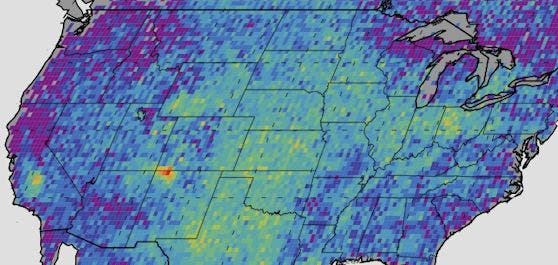A “massive methane hotspot” sounds pretty bad… and bad it is – much worse than scientists figured initially. In 2014, NASA reported that the methane hotspot is responsible for producing the largest concentration of the greenhouse gas methane seen over the United States – more than triple the standard ground-based estimate. But the methane, a potent greenhouse gas, might have even more drastic consequences on the climate of our planet.

The Four Corners area (red) is the major U.S. hot spot for methane emissions in this map showing how much emissions varied from average background concentrations from 2003-2009 (dark colors are lower than average; lighter colors are higher). Image Credit: NASA/JPL-Caltech/University of Michigan
Methane is a much more potent greenhouse gas than carbon dioxide, but thankfully, there is much less of it in our planet’s atmosphere. Methane is generated naturally by bacteria that break down organic matter and is commonly found in the guts of animals, from ants to humans. However, two thirds of the methane in the atmosphere was actually generated by humans, most notably through the burning of fossil fuels or through accidental release during drilling. The good thing is that methane only sticks around in the atmosphere for 11-12 years – so if we act quickly, we might actually see the results quite soon.
But the extent of the gas was grossly underestimated, as NASA learned just a year ago. But as scientists launch more efforts to understand the plume located above the Four Corners area, a darker warning looms over: is this an isolated case, or are there other methane hotspots, still undiscovered?
Nobody knows yet why Four Corners is giving off so much methane (an amount equivalent to almost 15 million tons of carbon dioxide, or the equivalent of adding 3.1 million cars to the road every year), but the main culprit seems to be coal – the Four Corners area is a well known and well developed coal mining area, though there’s no direct indication to show that coal exploitation is actually responsible.
Hydraulic fracking has also been linked to methane leaking, but all oil wells actually leak methane into the atmosphere to some extent, and this raises a lot of questions about the future of our planet’s climate – oil and gas may actually be contributing even more to climate change than previously thought. Now, NASA and the University of Michigan researchers have teamed up to figure out the Four Corners plume and understand if there are others like it. Hopefully, they’ll be successful. A lot seems to depend on it









